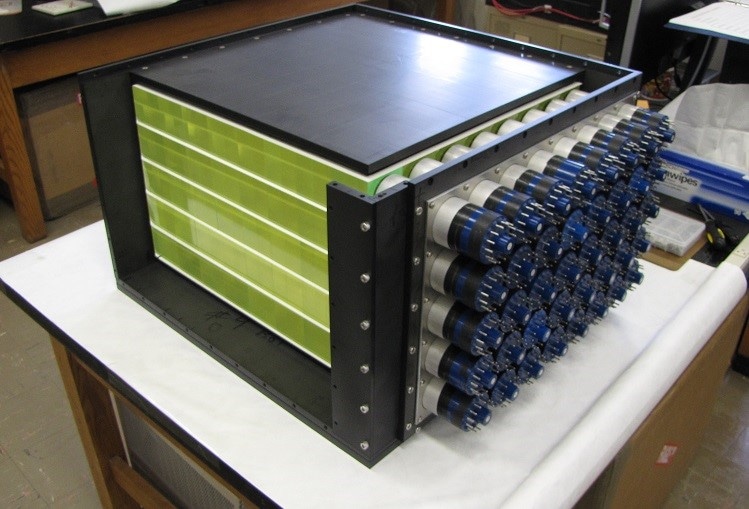Dec 7 2017
Innovative scientific discoveries indicate that neutrino detectors might have a significant part in ensuring safer storage and enhanced monitoring of radioactive material in nuclear waste repositories.
Scientists from Johannes Gutenberg University Mainz (JGU) have performed computations to determine the neutrino radiation emitted from used-up nuclear fuel. The computations indicated that neutrino detectors could be handy in specific scenarios.
 A prototype antineutrino detector for monitoring nuclear waste repository sites. CREDIT: Virginia Tech, Center for Neutrino Physics.
A prototype antineutrino detector for monitoring nuclear waste repository sites. CREDIT: Virginia Tech, Center for Neutrino Physics.
The fact that neutrinos almost do not interact with matter enables them to pass through the Earth or any human-made shield virtually unobstructed.
Every second about 100 billion neutrinos per square centimeter strike the Earth from the Sun, both day and night. Because neutrinos only weakly interact with matter, they are among the most difficult elementary particles to detect.
Professor Joachim Kopp, The PRISMA Cluster of Excellence, Mainz University
Kopp is a specialist in the field of theoretical neutrino physics and was awarded an ERC Starting Grant for his studies in 2014, one of the most highly bestowed awards from the European Union (EU).
When radioactive fission products undergo beta decay, large quantities of neutrinos are produced. Yet, the detection of the particles through the inverse beta decay process requires at least 1.8 MeV of energy. The particles can be only then registered in a scintillation detector — a tank including special mineral oils. Interaction of the high-energy particles with the protons inside the tank results in emission of a typical light signal.
Neutrino detectors such as these are already being experimentally used to monitor nuclear power plants during operation. Yet, to date, there are no detectors for monitoring stored nuclear waste.
“In-service reactors produce considerably more neutrinos than decommissioned reactors or stored radioactive material,” stated Kopp, indicating that monitoring the locations of nuclear waste is specifically crucial now for safety purposes.
Neutrino monitoring of spent nuclear fuel
In the study published in the journal Physical Review Applied, Joachim Kopp and Vedran Brdar from JGU and Patrick Huber from Virginia Tech, United States, initially computed the neutrino flux discharged by radioactive strontium-90 and other fission products contained in used-up nuclear fuel. Next, the researchers took into account a number of scenarios describing the way in which or the location in which the emissions can be detected. In one of the scenarios, an appropriate detector will be specifically helpful in monitoring above-ground storage sites, for instance, on-site at nuclear power plants.
In this scenario, a neutrino detector can detect whether radioactive material had been withdrawn even before documentation. As the computations indicate, measurements carried out with a 40-ton detector will have to be performed for nearly a year.
That sounds like a long time, but all that would be required would be to position the detector and wait. The big advantage is that we could verify the contents of a container without ever having to open it up.
Professor Joachim Kopp
Normally, it will be adequate to position the detector 10-100 m apart, for instance, on a truck trailer. As stated by Kopp, this technique may be specifically suitable in striving to make sure that nuclear weapons-grade material are not proliferated, the reason behind the interest expressed by the European Atomic Energy Community EURATOM in this research area.
In another scenario, the researchers computed a condition in which underground repositories have to be monitored, for instance, the proposed Yucca Mountain repository site in Nevada. In this condition, a notable amount of neutrino flux will be detected even on a small 10-ton tank’s surface.
However, some realistic hazards, such as the escape of very small quantities of radioactive material, would unfortunately not be detected.
Professor Joachim Kopp
The third scenario that the researchers worked on using their computations was the detection of inadequately documented storage sites, for example, facilities at the Hanford Site, a nuclear complex in the US state of Washington in disuse from the time of the Cold War. “In this case, the current detector technology is still not entirely sufficient, among other things because cosmic radiation distorts the measurements,” stated Kopp. Yet, the first prototypes for these detectors with the potential to overcome this challenge already exist.